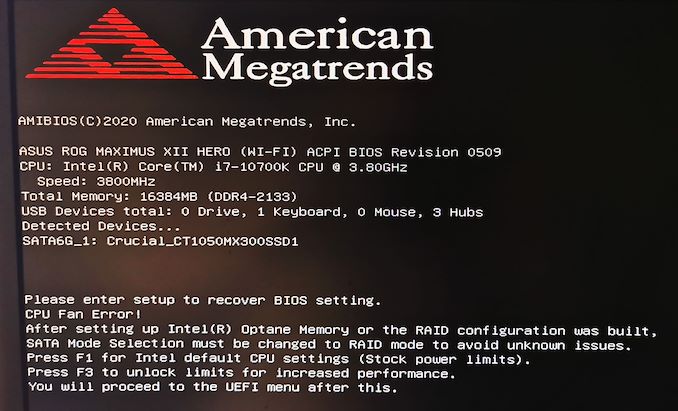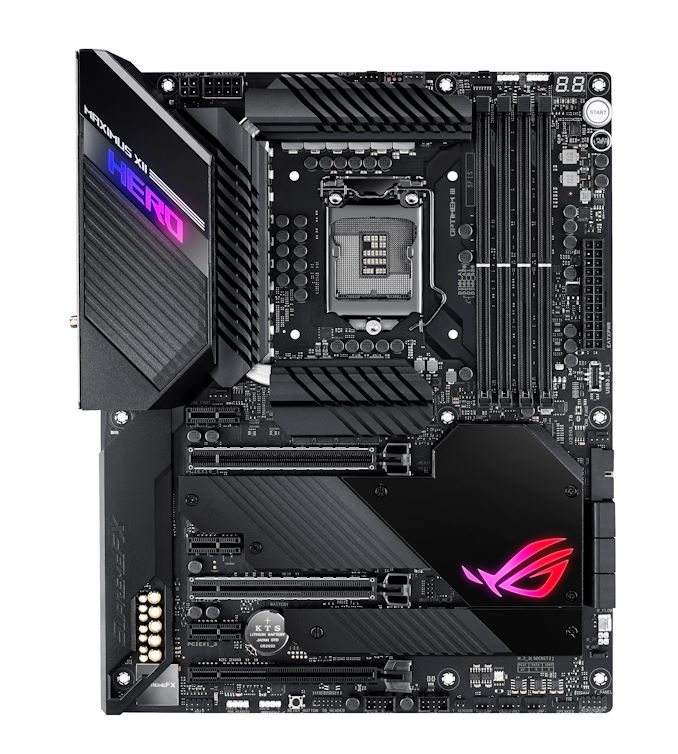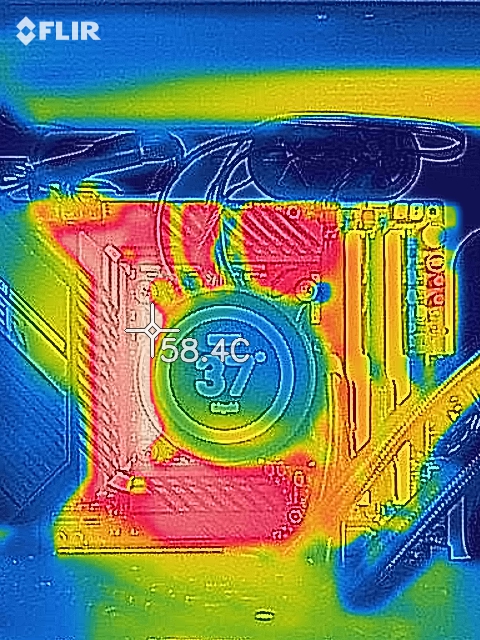ASUS ROG Maximus XII Hero Wi-Fi Review: The Tale of Two Motherboards
by Dr. Ian Cutress & Gavin Bonshor on June 11, 2020 11:45 AM EST- Posted in
- Motherboards
- Intel
- Asus
- ROG
- 5GBase-T
- Z490
- 10th Gen Core
- Comet Lake
-What's-Inside-the-Box_678x452.jpg)
Some of the recent discussions around motherboard design are whether the motherboard manufacturers are actually adhering to the CPU vendor specifications. If a motherboard manufacturer improves the base power delivery and cooling, should they be allowed to go beyond Intel’s suggested turbo power limits, for example? The question is actually rather moot, given that the vendors have been doing this for over a decade in one form or another, so varying degrees of extreme. As this practice has come more into the public light, especially with Intel’s high-end processors going north of 250 watts, companies like ASUS have come under increased scrutiny. That is why, at least with the Maximus XII Hero we are testing today, ASUS offers two options on the first boot: Intel Recommended, and ASUS Optimized.
ROG and Split Personalities
The fact that ASUS are offering users the difference between Intel Recommended and ASUS Optimized at first boot is rather intriguing. For sure it is a clear definitive statement that says that ASUS acknowledges that some users might be concerned about not following Intel guidelines, and the best people to know how do go above Intel’s guidelines are the enthusiasts that build systems on ROG. It’s a great way to provide base line and a boost line of just how far a product has improved upon Intel’s recommended values.
The worry comes when the board is to be used by a non-technical user. If they are unaware of the concept of going beyond Intel specifications, then they may not take advantage of the ASUS optimized values, aside from better thermals at the Intel specifications.
Nonetheless, it does mean that ASUS’ motherboards now have split personalities. Should the Maximus XII Hero now become donned in black, and called the Maximus XII Villain? [Hey ASUS, that’s a fun product idea. I’ll take 10%.]
The Hero sits in the middle of ASUS’ ROG Z490 range, despite being $399, but offers a substantial power delivery heatsink arrangement as well as coverings for the rear panel, chipset heatsink, and coverings for the onboard three M.2 slots. Connectivity is substantial, with a 5 GBase-T controller, an Intel I219 gigabit Ethernet, and Wi-Fi 6 as well. There’s even a USB 3.2 Gen2.2 20 Gbps connection on the back, among a myriad of other USB connections.
In our benchmark suite, we probed both the Intel Recommended settings as well as the ASUS Optimized selection. It was clear that that addition of those optimized settings gives the system a good boost in an array of benchmarks, but it is also clear that because other motherboard vendors are implementing their optimized values by default that most motherboards are competitive with each other anyway. For our load testing, we saw a +2% rise in a fully multithreaded benchmark with slightly lower power under the ASUS Optimized conditions.
The Hero scored obvious wins in our boot time test, our new NAMD test, and took our Core i7-10700K to 5.1 GHz before experiencing any throttling. The automatic overclocking was actually really good with load voltage compared to some others we have tested.
We pushed on to 5.2 GHz, just to see how the power delivery was holding up. The thermal results from the motherboard were very good on our probes, showcasing that the main limiting factor here for overclocked processors is going to be the CPU instead.
Naturally, motherboards over $300 should be viewed with suspicion. Normally motherboards priced above this are attached to some sort of gimmick, such as 20 SATA ports or a pre-fitted liquid cooling block. For the Maximus XII Hero, there are a number of premium components and features that make this a high-end board, and ultimately the goal here is to provide a good underlying base for any system. The Hero is really built for the overclockable processors though.
Motherboard Tested by Gavin Bonshor
Overview, Visual Inspection, and Conclusion by Ian Cutress.
Other pages written by Gavin Bonshor













29 Comments
View All Comments
Carlos_MaximaReview - Sunday, July 12, 2020 - link
At Maxima Review we hit 5.4 GHz over the air with the MSI ACE and a 10900K. If you do not believe you can visit us on the web, apart from facebook we also have a video to prove what I say. Greetings to Anandtech we are always in tune with your Review. Greetings from afar.AnnaSmith - Monday, July 20, 2020 - link
Glad to be here on your great site. https://federalprocessingregistry.comnatashadipth - Monday, August 3, 2020 - link
Is it accurate to say that you are searching for the best electric cutting tool?https://electricchainsawworld.com/ This rundown will assist you with picking the great one since it's a troublesome errand to choose which one is incredible as there are a ton of brands in the market offering their items, yet our surveys incorporate just first class cutting tools.sonyaroy690 - Thursday, August 20, 2020 - link
I am really looking forward to buying one but unable to find its detailed video review.https://bestblackfridaydeals.net/
AnnaSmith - Wednesday, September 2, 2020 - link
Awesome information you've shared here. https://www.wescoopthepoopokc.com/annaflux - Monday, November 30, 2020 - link
I am planning to make a new system for my office to perform some very basic stuff like posting content on https://bestbuysteamcleaners.com/ and a few other blogs along with using Adobe application. What should b e an ideal specifications for such computer?sonyaroy - Thursday, December 3, 2020 - link
I switched my system from ASUS ROG Maximus XII to msi meg z490 godlike and found much better results. http://zshadow.info/Tom Sunday - Tuesday, December 29, 2020 - link
Looking for Mobo deal at the computer show this past weekend the boys from Varanasi told me that Z490 buyers have been experiencing 'unsolvable' problems in getting their LAN to work. ASUS cannot help and is basically all talk. Not even a new BIOS update, driver hotfixes and new cables will help. Even INTEL updated drivers are not working. It appears that there are problems with the I225-V (LAN Chip) and Asus want to keep this issue hushed. Simply this being a hardware problem and no software or driver updates can permanently fix it. What has been done to date is only bandaging the problem. Many new Mobo purchaser's in frustration (disconnected their onboard NIC) and installed a new PCIE NIC and gotten it to work without a hitch! But its another $50 or so out of pocket to simply forego the downtime, hanging on the telephone and difficult RMA's. Will the new Z590 Mobo's in early 2021 get a new NIC chip? Anyway, the best advice is probably to stay away from purchasing any (2020) Z490 leftover boards using the embedded I225-V Ethernet controller and buy in a few weeks time a Z590 MOBO if INTEL is ones choice. Any Thoughts?Tom Sunday - Monday, January 18, 2021 - link
Hanging around our local strip center PC shop I found that many were looking to snatch Z490 Asus mobos on sale, now that the very expensive Z590's have been announced. But the word was still that ASUS Prime, Hero and the entire Strix lineup still maintain to have (Ethernet) LAN issues. Supposedly Asus has introduced a reissue of the boards with an actual LAN hardware replacement? Previous Bios updates and hours playing with new and old drivers never worked. But Amazon as late as this past December is still issuing RMA's and selling these boards with no LAN fixes. Looks like many such boards are still on the shelves with these problems. How do I differentiate a Hero board which apparently has the hardware Lan fix? I checked Gigabyte at Amazon and found none of these LAN issues among the certified buyers. I have been using Asus mobos for a long time but now the story goes on...what's the scoop? WTF!